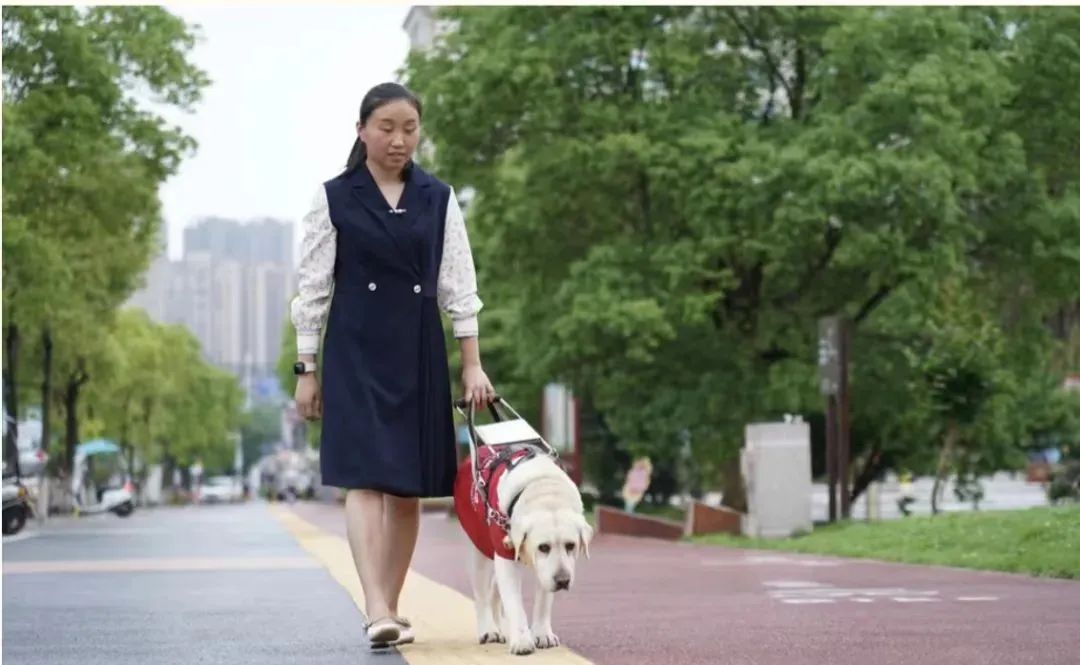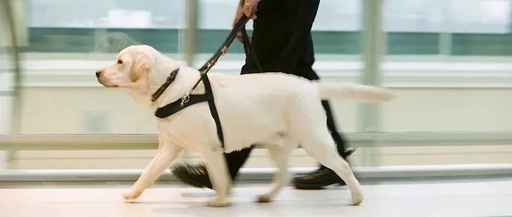Dialogue Guests
Liang Jia(Director of the Administrative Department, Dalian Guide Dog Training Base)
Wang Xing(Director of Xi’an Sunshine Messenger Guide Dog Development Service Center)
Wang Tingzhao(Director of the Special Education Department, Shaanxi Normal University)
Li Weiyu(Principal of Xi’an Enlightenment School)
Have you ever seen guide dogs wearing red vests on the streets, at stations, or airports? How many adorable and loyal guide dogs like “Xiao Q” and “Dick” are there in China now? How are these “dog stars” trained, and how do they cooperate with visually impaired individuals? How can guide dogs and their handlers integrate into society more “accessibly”?

‘Accessible’ Civilization: Making Guide Dogs No Longer Disdained
Liang Jia: A significant milestone for the guide dog movement in China was the opening ceremony of the 2008 Beijing Paralympic Games, where athlete Ping Yali walked into the Bird’s Nest with her guide dog, becoming the second-to-last torchbearer. This scene marked the beginning of many Chinese people’s understanding of guide dogs. Over the years, the rights of guide dogs and their handlers have been greatly protected, with clear provisions in both the Disability Protection Law and the Accessibility Environment Construction Regulations, fully supporting and safeguarding the rights of people and dogs to access public spaces.
Wang Xing: Since last year, two events in Shaanxi have brought guide dogs into the spotlight: at the National Paralympic Games, two guide dogs trained at the Dalian base accompanied their visually impaired owners to the blind gateball competition, garnering more attention than the competition itself; at a concert held at the Xi’an Concert Hall, two guide dogs accompanied their owners to enjoy elegant music. These two public events have earned guide dogs “thousands of loves”.
Guide dogs being accepted and treated well across various regions reflects new progress in the civilization of a great nation. The construction of an “accessible” society, matched with the soft and hard infrastructure of social civilization, is one of the indicators of modernization. Smooth pavements, tactile paths, and handrail ramps are part of the physical environment construction for accessibility; relevant laws, regulations, and policies, as well as education, employment, and equal participation of visually impaired individuals in cultural and sports life, constitute the construction of a civilized environment for accessibility.
Wang Tingzhao: The process of building an “accessible” social civilization in our country still has a long way to go. Today, there are still some public places that do not allow visually impaired individuals to bring guide dogs inside, treating guide dogs as ordinary pets, leading to behaviors such as watching, feeding, petting, and calling out, which interfere with the normal work of guide dogs.
Public unfamiliarity and lack of acceptance create difficulties for guide dog users, causing some visually impaired individuals who wish to apply for guide dogs to hesitate. We call on the public to accept guide dogs and raise awareness about them.
Training a Guide Dog is as Challenging as Training an Athlete
Liang Jia: In 2006, the Dalian Guide Dog Training Base was established, and it can stably train 40 guide dogs each year. Training institutions for guide dogs have also been established in Xi’an, Shanghai, Guangzhou, and other places. Additionally, some guide dogs are directly imported from overseas. Currently, there are fewer than 400 guide dogs serving nationwide. The international standard for the prevalence of guide dogs is that at least 1% of visually impaired individuals in a country should use them.
Wang Xing: The willingness of some visually impaired individuals to integrate into society has increased, leading to a growing demand for guide dogs. In Xi’an alone, I received over 300 applications within a year. The number of guide dogs trained in China each year is far from meeting the demand.
Training a qualified guide dog is as challenging as training a professional athlete. First, we need to select the right breed; for example, from a litter of Labrador Retrievers, we look for the one that is more stable and less “excitable” in group living. Then, we take it through several months of socialization to familiarize the puppy with environmental noises and sounds, followed by over 30 training items, including physical fitness, agility, and coordination. If any one of these items is not passed, the training is deemed a failure.
After obtaining the “qualification certificate,” guide dogs must complete a matching process with their new owners, which can take from two months to half a year, familiarizing themselves with the routes their new owners frequently walk in their work and daily life, ultimately integrating into the households of visually impaired individuals.
Liang Jia: The success rate of training guide dogs at the Dalian base has increased from 10% to 45% to 50%, meaning that one out of every two trained dogs can take up a working position. Other domestic bases also achieve similar success rates.
Wang Xing: Currently, we consider matching qualified guide dogs with those disabled individuals who need them the most, such as those who require guide dogs for work. We have matched one guide dog with a pair of visually impaired massage therapists, as one guide dog can serve two disabled individuals in a family.
To find the most suitable candidates, we communicate multiple times with applicants, conduct home visits, and observe whether their families can accommodate a dog, considering factors such as family size, members, and income. Since all domestic guide dog institutions are non-profit, they do not charge “rental” or usage fees for guide dogs. The cost of adopting a guide dog is not high, requiring only about 600 yuan per month for dog food, which is negligible compared to the average training cost of 200,000 yuan for a guide dog. In the future, we also plan to purchase insurance for working guide dogs to cover any injuries or accidents that may occur during work, alleviating the financial burden on their handlers.
Where Do Retired Guide Dogs Go?
Wang Xing: In the past, guide dogs that failed training were converted into pet dogs and given to loving families for adoption. Because these dogs generally have high quality and are well-trained, they are favored by adopting families. However, for our training institutions, the efforts previously invested can be considered wasted, as we hope that the carefully selected dogs can serve more people in public domains. In fact, with slight adjustments to the training content, these dogs can be used in search and rescue, education, psychological therapy, and comfort roles.
Li Weiyu: We are collaborating with Shaanxi Normal University to select three high-grade elementary school children with autism, allowing therapy dogs to participate in their rehabilitation and education through reading, games, and companionship. Teachers will assign meaning to the dogs’ behaviors, using the dogs’ inherent affinity and role-playing to stimulate children’s motivation to attempt language or verbal participation.
Wang Tingzhao: The theoretical basis for animal-assisted interventions includes attachment theory, biophilia hypothesis, and anthropomorphism. Transforming guide dogs into therapy dogs to serve individuals with mental disabilities, especially adolescents, has already been successfully implemented in foreign cases, such as improving children’s motor skills, social skills, and learning interests and motivations. This practice is still a frontier field in our country.
Dogs and humans primarily interact through companionship and interaction. We will focus on mild mental disabilities or other special education fields, allowing more “retired” guide dogs to become therapy dogs, comfort dogs, and companion dogs, maximizing their value.
Source:“Bimonthly Talk Internal Edition” 2022 Issue 6Bimonthly Talk Reporters: Zheng Xin, Zhang Chenjun | Editor: Zheng XuejingEditor-in-Chief: Qin DaixinProofreader: Guo Yanhui

